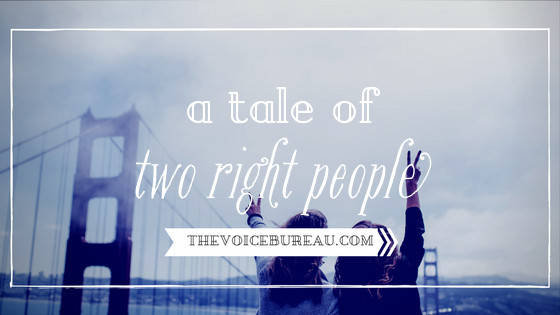They were the best of clients, they were the worst of clients.
If you’ve been in business long enough — or if you’ve done a good bit of soul-searching and research and strategizing — there’s a pretty good chance you have an idea of what type of client you enjoy working with the most (or maybe you’ve found them by learning what type of client you enjoy working with the least).
These are the clients who trust your process, who get excited whenever you have a new offer, who speak your language. Your tribe, if you’ve got that Community drive going for you. Your friends, if you’re more Intimacy.
We call that client your Right Person, and the more you know about her (or him or them), the better you’re able to serve her.
But what if you find that you have two Right People…and they’re not exactly identical twins?
Don’t freak out. Believe it or not, this is completely normal.
If you’re building your business for longevity, there’s a pretty good chance you’ve started to diversify a bit. Maybe instead of just selling hand-poured beeswax candles, you’re now offering candle-making lessons. Rather than doing all of your yoga classes in a group setting, you’re now offering one-on-ones. Instead of just copywriting, you’ve added consulting and courses. Ahem.
The point is, diversity is good — different types of offerings cast a wider net, appealing to different people in different situations. It brings you more outlets to share your knowledge, more streams of income, more opportunities to connect.
But there’s a very good chance that the type of person interested in one of your offerings is not the same as the type of person interested in another.
Let’s look at an example.
Let’s say there’s a productivity coach. Why don’t we call her Eva.
Eva has been in business for a while, supporting mainly solopreneurs in a one-on-one coaching setting, with an average of three sessions each. Her Voice Values are Intimacy, Helpfulness, Depth, and Clarity.
Now, Eva is looking to bring on some more clients. She’s planning to start up a group program: six months of intensive support, culminating in a live, four-day retreat. The problem is, her regular clients aren’t biting. So what gives?
Well, let’s examine Eva’s original set of clients. She’s been doing this a while, so she’s able to say that these clients are mainly women who are self-employed, age 27-45, mostly in the fairly early stages of their business. Many of them are married with children, and they need some help organizing their schedule to fit everything in without too much stress or lack of sleep. Their three sessions tend to go: introduction and overview, suggested routine, follow-up and adjustments. Some of the clients come back after a year (or maybe once every year) for a fine-tuning, but for the most part, once they’re done, they’re done. Her clients do love reading her blog for additional tips, though, and they make up a pretty active community in the comments and on social media.
So, if these clients are so active in her community, why aren’t they signing up for the new program?
The key is in figuring out what’s different about this program. Rather than three one-on-one sessions, they’re looking at six months in a group. So, for one, this is someone who needs more ongoing — and possibly more complicated — support than Eva’s usual clients. Maybe they’ve been in business longer and have more pieces to juggle. Maybe they’ve got a team to think about, either in-person or virtual. They’re interested in working with a group, rather than one-on-one, so there’s a good chance they see the benefit in networking. They may even be more extroverted than Eva’s regular clients. It’s going to be a larger commitment, but in time and financially (especially given the in-person retreat), so they’re probably making more money, and there’s a good chance they skew a bit older. They may or may not have children.
So what’s a productivity coach to do? Well, create a couple of Right Person Profiles, to start. This is an exercise we like to do (and, yes, something we can help you do for yourself), in which you create an imaginary story about your ideal client. Give her a name. A job. A house. How old is she? Where does she live? Is she married? Kids? Where did she go to school? What’s her favorite thing to eat for dinner? The more detail, the better. Find some stock pictures and imagine what she looks like.
Now, take a look at your own Voice Values. What is she drawn to because she sees herself, and what appeals to her because she needs more of it in her life?
For Eva, her one-on-one clients probably relate to her high Intimacy value, because they prefer to work closely, alone with her. They appreciate the Helpfulness and Clarity she brings to their lives (and their schedules). But her group clients — even though they meet in a larger setting — are probably drawn to her high Depth value, because they’re looking for more ongoing support, a deeper, more lasting connection. So when Eva is talking to each group, she’ll want to tailor the texture of her language — keeping it true to her Voice Values, but speaking directly to the client she wants to work with.
With a clearer picture of her new Right Person, Eva can create a sales funnel that speaks directly to her, addressing her needs, speaking her language, and showing her exactly how this new group program will help support her. She might even restructure her webpage so that each Right Person can more easily find the section that supports her. (Using modules on the Home Page is a good way to do that, or at least clearly defined menu options.) She can even apply this understanding to her blog posts, speaking directly to the Right Person most likely to be interested in each subject.
The more you know your Right Person — or Persons — the better you can tailor their experience to suit them, and the more seen they will feel.
Now just wait until Eva launches a DIY option…
In the comments, I’d love to hear:
How many Right People does your business have? How do you treat them differently (or do you)?
{ 0 comments }

 Hello, you.
Hello, you.